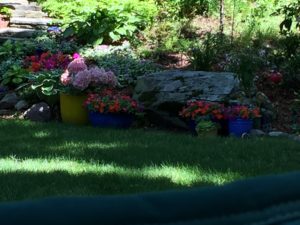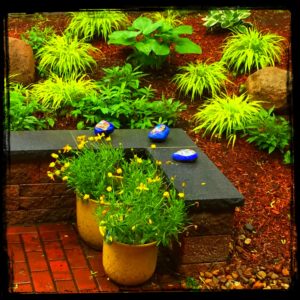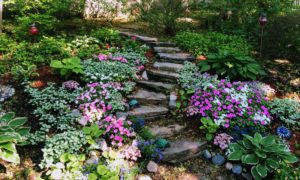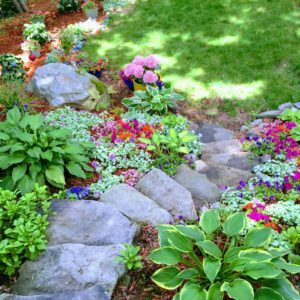“If I can make it there, I’ll make it anywhere.”
I sing those words to newly-purchased plants I drive them home. My garden, rather than a zone of tender nurturance and rule-following is a survival of the fittest zone. I began gardening on a whim, with containers in the front of my then-narrow townhouse, and the mass of unrelated, unplanned, and, often, unsuitable-for-the-space flowering plants I chose that crowded the back.
(I barely knew the difference between annuals and perennials).
And yet, despite the morning glories who tried to consume everything in their path, the soil more stone than dirt, and my lack of proper tools (not knowing the difference between a spade and a trowel) the gardening bug hit, and it hit hard. (I think it was my success with containers and impatiens. (Which led to secrets number one and two)
- When I filled containers with impatiens or other flowers, I ignored all spacing directions about placing the starter plants X inches apart. Crammed those babies in. #Gratification. You’ll end up with an overflowing pot of flowers in no time—not like those skinflint pots of your neighbors. (Of course, when using this rule, one often ends up having to dig up and move things.) Which is okay with me—cause I love being in the garden.

- Know when to fold em, know when to hold em. When the morning glories invaded, I tore them out. There. I said it. I didn’t coax them into a better growing pattern. I didn’t talk them out of invading. (Which probably also explains my inability to keep orchids past their blooming period. Yes. I know the orchids will bloom again in a year or five, but my nom de plants is the impatient gardener.
- The next secret renames me as the evil gardener: when in doubt, rip it out. Like #2, but more malevolent. I’m talking innocent plants whose only crime was ending up with me. When we bought our current home, the yard was rubble hidden behind scraggly bushes. My experience all came from containers and my tiny plot of morning glories and friends. The landscape person, who put in the initial large plantings, picked a few that I let myself be talked into and grew to loathe. After a few years of gaining mastery over the soil (sort of) and self-confidence, I destroyed them. (I will admit that now I would try to replant them in a hidden part of the garden. I’ve gotten soft.)

- Water with as little work as possible! Our yard (front and back) is fair sized. And I’ve planted every inch I could. And watering during dry spells could take ages. And as much as I love gardening, I hate watering. So, I convinced my husband that investing in a small sprinkling system would save us money in the long run. (Because laziness + dry spells = losing all those plants I’ve bought!) So now I hand water a few sections and my container pots. And pray for rain.
- Use rocks! Hide your mistakes! Artful large stones mask a myriad of problems. Bald spots where I forgot to space well (see Sinatra tip above)? Paint a rock or hundred and scatter. Don’t feel satisfied with your transitional areas? Mark with rocks. Want to amuse a child? Rock painting will amuse them—and more important, turn your children and grandchildren into artistic laborers working for your garden. When they become a bit old for enjoying a day of turning out twenty-five rocks, make it into their summer job—but beware of paying by the piece or they’ll churn out one faux-modern art monstrosity after another. Pay by the hour, and you’ll get better product.


- Resist online plant buying, unless you have the eye of a professional. Inevitably they appear when you no longer want to plant one more thing. Or, the lush hosta you saw on the page turns out to be (this happened to me) a minuscule finger length plant. That never grew beyond the arrival size. While online buying appears to give instant gratification, (I see! I buy!) going to the nursery, letting the right plant lure you and being able to consummate the deal that afternoon? Heaven.

- Get the right tools. This I learned the hard way. Though getting a ready-made bucket of 100 gadgets for ten bucks is tempting, I’ve learned that buying one perfect hori knife, a well-crafted D-shovel, and the perfect kneeler saves my back and arms. Ibid, the right trowel and balanced spade.
- Mulch. Work once and be lazy for the rest of the summer.
- Weeding is no fun; so make it a game. Pick one medium-sized bucket or basket and tell yourself you only need to fill it once a day. Inevitably, you’ll go back for more—but if you don’t, no worries! Add another bucket for deadheading.
- If you can’t get approbation anywhere else, get it from your garden. My lazy method for the wow factor is filling large areas with the least labor-intensive plants—ones that flower all summer, require no dead-heading, and that brighten up the garden. Masses always look welcoming—especially as you look out from your air-conditioned living room. Show off your garden as though you’re a three-year-old holding up your finger-painted masterpieces. . . drag folks through your yard each time you plant even one new flower. Just like Sinatra would.






